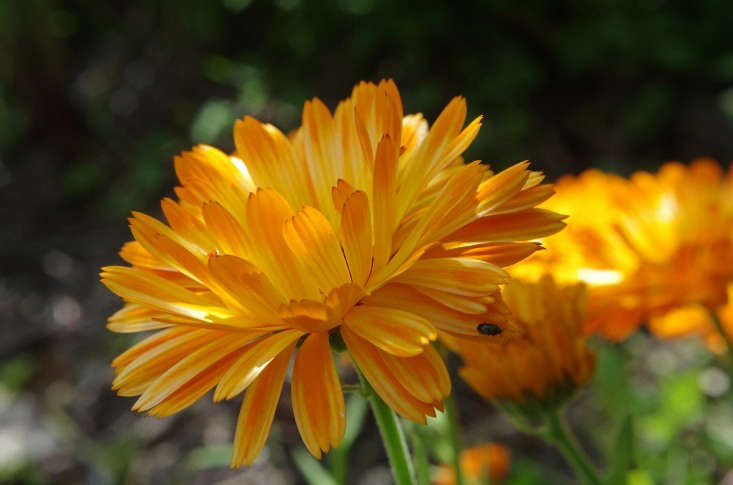Pot Marigold, Calendula officinalis: “Faithful Companion”
I really want to be that type of gardener who plants by scattering seeds, but I struggle with getting them to successfully germinate. Except for a few—including calendula. I have a tiny area in my garden where a couple seasons ago I broadcasted a seed mix of about 10 different plants. A few days later, one broke through the surface of the soil: calendula.
But beyond its stalwart germination habits, calendula also has medicinal uses, as a natural anti-inflammatory remedy that is helpful in healing wounds. (I always have a tube of calendula cream in my first aid kit for all types of skin care needs.)
Please keep reading to learn more about this multi-talented flower:

Calendula is an undeniably reliable cool-season annual typically growing 18 to 24 inches tall and producing a spectacular display of deep orange or yellow daisy-like blooms from early summer until frost.


Also used medicinally, calendula is used in salves, lotions and other beauty products because it’s hypo-allergenic and its anti-inflammatory and anti-bacterial properties sooth and restore the skin, providing relief for minor rashes and irritations. Crafty DIY types can make a simple healing calendula oil from the petals. I am full of craftiness but short on time so I purchase my calendula oils and creams.
Calendula has been a British cottage garden staple for centuries. The reason? Calendula fits the plant requirements for a cottage garden: it reseeds itself, is both ornamental and edible, attracts pollinators by the droves, and is rambunctious and carefree, not in the least contrived or pretentious.

A little more history: the Romans grew calendula for both beauty and to relieve scorpion bites. The early Christians used to give the name of the Virgin Mary to plants that they saw as extraordinarily beautiful: marigold, for instance. In the New World, European settlers used calendula to stop bleeding and made an ointment from the blossoms to use for wounds and for painful bee and wasp stings (this ointment was used during the Civil War). And the common name “pot marigold” came from the fact that it has a long history of being used in cooking.

Cheat Sheet
- Calendula is bold and cheery in patio pots and mixed perennial beds.
- Insects and disease are typically not a problem. In fact, calendula may deter harmful insects and draw aphids away from other plants, making it a great companion plant for vegetable gardens. For added insect protection, plant with chard, carrots, and tomatoes.
- Attractive bright, double blossoms are much appreciated by beneficial insects such as bees, butterflies, ladybugs, and lacewings.
- Edible flowers and leaves add a bright zest to summer salads or mixed into cream cheese. Children find the notion of edible petals irresistible. Tip: Make sure you grow calendula without chemicals or pesticides.

Keep It Alive
- Thrives in full to part sun with average watering.
- Best planted in prepped beds or containers, amended with organic compost to provide good drainage. After emerging, add a layer of compost to conserve moisture and help keep roots cool.
- A cool-season plant, calendula can be started indoors 6-8 weeks before the last frost or directly seed outdoors after the last frost. Seeds germinate in 5-15 days. 6-packs starts can also be purchased at your local nursery.
- Orange and yellow blossoms bloom all summer, but let some go to seed by not pinching off a few flowers so you will have more for next year. When the blooms dry out, cut them off and hang upside down in bundles. Once dry, the seed heads can be lightly hand-crushed to remove the seeds.
N.B.: For more growing and design tips, see Calendula 101: A Field Guide. And for more inspiration, see:
- DIY Natural Remedy: Calendula Oil from Obercreek Farm.
- Back to Nature: Plant Dyes from Permacouture.
- First Aid Kit: 5 Essential Healing Plants for Summer.










Have a Question or Comment About This Post?
Join the conversation